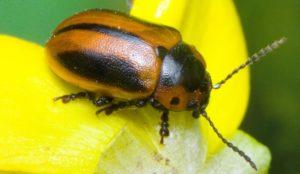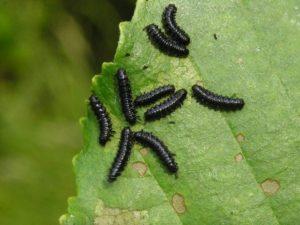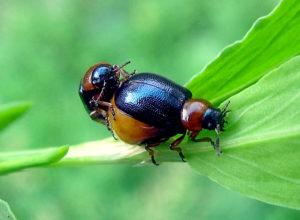Leaf beetles: a family of voracious pests
Invasions of pests are dangerous for the garden and vegetable garden. During the season, farmers keep a close eye on plants and trees to prevent pests. One of these are leaf beetles. They destroy plants very quickly.
Content
What does the leaf beetle look like: photo
Description of the leaf beetle
Name: Leaf beetles
Latin: ChrysomelidaeClass: Insects - Insecta
Squad: Coleoptera - Coleoptera
 | Habitats: | everywhere |
 | Dangerous for: | greenery and flowers |
 | Means of destruction: | chemical and biological agents |
Leaf beetles are one of the largest families. The size of the body of the insect is small. The body length varies from 3 to 15 mm. The body is oval or round.
Color can be yellow, white, green, brown, black, dark blue. It depends on the type of insect.
Width body almost 2 times less than the length. The body may be naked or covered with scales, hairs. Beetles have a well-developed pair of transparent wingletshaving convex elytra. There are dots on the wings.
Mustache in the form of threads and directed forward. Limbs are usually short. Female individuals have more impressive dimensions. The body of the larvae has a straight or arcuate shape. There are bristles on the body.
The number of eyes is affected by the type of insect. The maximum number of eyes reaches 6. Hidden-living species have no eyes.
Leaf beetle life cycle
Mating takes place in the spring. Females lay on the underside of the leaves or on the ground. One clutch contains from 5 to 30 eggs. During the entire life cycle, females can lay from 400 to 700 eggs.
The eggs are very conspicuous. They can be bright yellow, yellow-gray, dark red.
After 1-2 weeks, larvae appear. Initially, the larvae feed all together. Later they grow and are placed separately on leaves and roots.
Next, the pupation process begins. It takes up to 10 days. Places of pupation - leaves, lower part of the trunk, bark cracks, soil up to 5 cm deep.
Mass flight occurs at the end of June. The number of generations is influenced by the variety and region of residence. Temperate climate relies no more than 2 generations. Beetles hibernate under fallen dry leaves or under lumps of earth.
leaf beetle diet
Pests feed on leaves and shoots of young plants. Adults are engaged in eating small holes in the leaves, and the larvae are eating away the internal tissues. Only the veins remain intact.
The larvae damage the lateral roots and hairs. They gnaw holes in the stem, retaining nutrients and water. This leads to the death of leaves, trees, shrubs.
Popular species and their distribution
Leaf beetles occupied all continents. They can be found in any country. They are able to survive in different climatic zones. The exception is the North and South Poles.
Each species differs in size, body shape, color, habits. Of the most common, it is worth noting a few common ones.
Prevention of the appearance
Preventive measures include:
- destruction of weeds;
- cutting and burning dried branches and faded flower stalks;
- deep loosening of beds and row-spacings;
- soil harrowing in spring.
Leaf beetle control methods
Leaf beetles multiply rapidly. Protection methods are selected depending on the number of insects and the time of year.
Chemical and biological preparations
With the mass appearance of pests, it is difficult to do without chemicals. Stop insecticide treatment one month before harvest. Karbofos, Karate, Phosbecid, Kemifos, Fitoverm have a good effect.
An excellent option would be Bitoxibacillin - a biological agent that can destroy the leaf beetle without a toxic effect on other plants.
Folk methods
From folk remedies, mixtures are suitable:
- 0,5 kg of minced garlic with 3 liters of water. Insist for 5 days and process;
- 0,1 kg of dry mustard is added to a bucket of hot water and infused for 48 hours. Dilute with water in equal parts and spray.
It is recommended to add 20 g of soap to each mixture to keep the composition on the plants. Dusting with wood ash will also help.
Conclusion
Leaf beetles pose a great danger to trees, shrubs, and plants. Annual prophylaxis will reduce the likelihood of pests. When parasites are found, they begin to fight them by any means.
Previous

